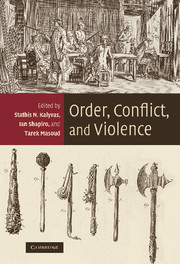Book contents
- Frontmatter
- Contents
- List of figures
- List of tables
- List of contributors
- Preface
- 1 Introduction: integrating the study of order, conflict, and violence
- Part 1 Creating, maintaining, and restoring order
- Part 2 Challenging, transforming, and destroying order
- 8 Civil wars and guerrilla warfare in the contemporary world: toward a joint theory of motivations and opportunities
- 9 Clausewitz vindicated? Economics and politics in the Colombian war
- 10 Articulating the geo-cultural logic of nationalist insurgency
- 11 Which group identities lead to most violence? Evidence from India
- 12 Order in disorder: a micro-comparative study of genocidal dynamics in Rwanda
- 13 Sexual violence during war: toward an understanding of variation
- 14 “Military necessity” and the laws of war in Imperial Germany
- 15 Preconditions of international normative change: implications for order and violence
- 16 Promises and pitfalls of an emerging research program: the microdynamics of civil war
- Index
- References
10 - Articulating the geo-cultural logic of nationalist insurgency
Published online by Cambridge University Press: 06 July 2010
- Frontmatter
- Contents
- List of figures
- List of tables
- List of contributors
- Preface
- 1 Introduction: integrating the study of order, conflict, and violence
- Part 1 Creating, maintaining, and restoring order
- Part 2 Challenging, transforming, and destroying order
- 8 Civil wars and guerrilla warfare in the contemporary world: toward a joint theory of motivations and opportunities
- 9 Clausewitz vindicated? Economics and politics in the Colombian war
- 10 Articulating the geo-cultural logic of nationalist insurgency
- 11 Which group identities lead to most violence? Evidence from India
- 12 Order in disorder: a micro-comparative study of genocidal dynamics in Rwanda
- 13 Sexual violence during war: toward an understanding of variation
- 14 “Military necessity” and the laws of war in Imperial Germany
- 15 Preconditions of international normative change: implications for order and violence
- 16 Promises and pitfalls of an emerging research program: the microdynamics of civil war
- Index
- References
Summary
Introduction
As interstate wars become less frequent, academic attention has increasingly shifted to internal conflict. In recent years, an exciting literature on the determinants of civil wars has emerged. Political economists, relying on cross-national statistics and rational-choice modeling, have played a prominent role in this debate. In contrast to most past attempts to account for domestic unrest, they tend to explain outbreaks of civil wars in materialist and logistical, rather than cultural, terms.
There can be no doubt that this kind of analysis has advanced the research frontier considerably. Instead of offering sweeping generalizations based on diffuse and scattered case-study evidence, the political economy literature has brought the phenomenon of civil conflict into sharper focus, thus allowing for a more precise evaluation of competing hypotheses. Still, it would be premature to draw definitive theoretical conclusions from these studies because a considerable gap remains between their macro-level findings and the rationalistic micro-level mechanisms that they posit as explanations.
Questioning these scholars' heavy reliance on materialist factors, this essay proposes alternative causal mechanisms that bring both politics and culture back to the fore. This task calls for deeper and more systemic explanations than those associated with the standard methods and assumptions of microeconomics. Therefore, I rely on computational modeling, which is better suited to trace historical path-dependency and to capture intangible entities such as national identities.
- Type
- Chapter
- Information
- Order, Conflict, and Violence , pp. 242 - 270Publisher: Cambridge University PressPrint publication year: 2008
References
- 10
- Cited by



